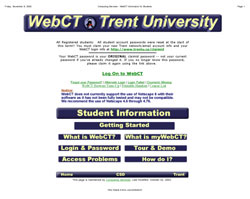
| Daily News | News Releases | Special Bulletins | Feature Archives |
| The View from Trent | Trent Magazine | Focus Trent | Build 2000 |
Sharing
knowledge:
Two professors discuss WebCT experiences
 The
Trent Interactive Learning Centre (ILC) organized a presentation Tuesday,
November 12 for faculty members about Web CT. Drs. Alan Slavin and Rachel
Wortis from the Physics Department and Dr. Jonathan Swallow, the Interactive
Learning Centre's Instructional Designer, discussed the application of
WebCT to encourage students to do assigned readings before coming to class.
This WebCT application has been used to improve the level of small-group
discussion in a lecture setting. A detailed summary of their presentation,
"Just-In-Time-Teaching applied with Peer Instruction using WebCT,"
is available on-line at http://www.trentu.ca/ilc/program_2002-03.html.
The
Trent Interactive Learning Centre (ILC) organized a presentation Tuesday,
November 12 for faculty members about Web CT. Drs. Alan Slavin and Rachel
Wortis from the Physics Department and Dr. Jonathan Swallow, the Interactive
Learning Centre's Instructional Designer, discussed the application of
WebCT to encourage students to do assigned readings before coming to class.
This WebCT application has been used to improve the level of small-group
discussion in a lecture setting. A detailed summary of their presentation,
"Just-In-Time-Teaching applied with Peer Instruction using WebCT,"
is available on-line at http://www.trentu.ca/ilc/program_2002-03.html.
WebCT stands for "Web Course Tools" and is a piece of software for the management of Web-based classes. WebCT allows educators to do everything from creating entire on-line courses to publishing lecture notes.
There are currently 5,000 students at Trent with established WebCT passwords and log-ins. There is an average of 2.5 courses per student with information available on-line. Two Trent courses – history 320 and one 50-student section of first-year psychology – are completely Web-based in nature.
"The most popular use of WebCT by students is discussion groups," explains Trent WebCT Administrator Mary Jane Pilgrim. "They can log on in off hours and, within that setting, every student has a voice. There’s no time limit and you never reach the end of a class with your hand still up."
Ms. Pilgrim adds that ESL or special needs students can enjoy extra time to compose comments and review what they have written.
How it works is this: a student goes to www.trentu.ca/webct. They log in (using their name and password). All of their courses that include a WebCT component show up on their computer screen, with subheads indicating which services the student can access in each course. Some options may include viewing on-line lecture notes, reading course announcements, reviewing the course calendar and assignment details, surfing related Web links and joining a class discussion. Professors may opt to include basic quizzes, and the WebCT software also displays individual marks to each user.
"Instructors like it and they find it easy to use. Students really like it, too," says Ms. Pilgrim.
Some concerns have been voiced about WebCT removing the "personal touch" from a Trent education. However, Ms. Pilgrim feels the software, if used properly, only enhances the learning that is already going on.
"The way professors are using WebCT, it complements what’s happening in the classroom. It shouldn’t detract from traditional learning," she says.
Ms. Pilgrim completed three-quarters of her own masters degree on-line through UofT and found the process was effective. "A real community developed and I feel I spent more time working on my courses," she says, adding she has been working on developing WebCT at Trent for three years. Throughout that period, faculty involvement in WebCT has grown by leaps and bounds, as evidenced by the 50,000 hits to the WebCT Web site in October.
The numbers speak for themselves, and it certainly seems students want to access course information through this new medium. Perhaps that just makes sense in today’s computer-savvy society.
Posted November 8, 2002
![]() Return to Trent Home
Return to Trent Home
Maintained by the Communications
Office
Last updated
November 20, 2002